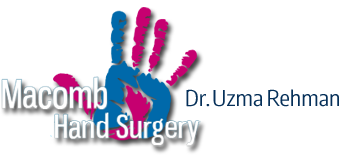What is a Jammed Finger & How to Treat It
When a blunt force strikes the end of a finger, it can damage the ligament and cause a condition commonly referred to as a “jammed finger”. Jammed fingers can be mild or serious, and mildly uncomfortable to very painful.
Treatment for a jammed finger will depend on the degree of the injury and the severity of the symptoms.
What Is a Jammed Finger?
When a finger gets “jammed” it can rotate or hyperextend the middle joint (knuckle). This can stretch or tear the ligaments and/or the thick pad on the bottom. It also often breaks off a piece of bone in the process.
The middle knuckle is highly specialized – bending up to 120 degrees and carrying up to 50 pounds. Therefore, it is very easily injured. Most commonly, a jammed finger occurs to the middle finger because it was the longest.
Causes of a Jammed Finger
A jammed finger is most common during sports, but it also often occurs during regular daily activities or when performing occupational duties ‘on the job’.
Ligaments are soft tissues that connect the bones to each other. A jammed finger occurs when the tip or end of the finger is pushed inward toward the hand. As the finger is compressed, the ligaments around the joints are stretched (“sprained”). The greater the force on the ligaments, the more severe the sprain will be – and if the force is strong enough, the ligaments can be torn.
Playing sports, a finger can be jammed by a ball, running into another player, or slamming into a stationary object. Jammed fingers are also common when grasping the steering wheel during an automobile accident, or when putting the hand down to break a fall. But jammed fingers can also be caused by something as simple as closing a drawer or door on the finger.
Symptoms of a Jammed Finger
A jammed finger may result in pain, swelling, and the inability to bend, straighten or grip with the finger.
It also may or may not be accompanied by a fracture (break) in the bone – in which case the pain and swelling is typically much worse.
Remember that the anatomy of the finger joint is very complex – so if injuries are left undiagnosed or untreated they can result in permanent problems. So, if pain or swelling persists – even if the finger looks normal and can move normally – it may still require medical treatment.
Treating a Jammed Finger
If a jammed finger is not severe and you do not suspect a fracture (broken bone), it can often be self-treated at home. Temporarily immobilizing the finger and protect the finger from further injury by “buddy taping” it to another finger can help. And, of course, take a break from sports or other activities that could jar or reinjure the finger.
Icing can help decrease inflammation and dull pain, by applying a cold pack to the joint for 5 to 10 minutes every hour or two. Over-the-counter anti-inflammatory pain medication, such as ibuprofen (Advil) or naproxen (Aleve), can also be taken as needed.
However, if pain, swelling, or limited mobility persists it is essential to see a hand doctor to prevent long term damage. Similarly, if the finger appears misaligned, do not attempt to realign yourself – and immediately seek medical attention.
Similarly, if the finger’s range of motion is significantly limited, see a hand doctor as soon as possible. Limited range of motion can be a sign of a partial dislocation and/or a fracture (broken bone).
Seeing a Doctor for a Jammed Finger
Your hand will conduct a thorough physical examination to evaluate the finger position, movement, mobility, pain and swelling. Typically, X-rays will be taken to rule out a fracture, and other studies may be needed – such as an MRI or CT scan – to examine the soft tissue.
Milder jammed fingers can be treated with a splint and/or buddy strapping to the next finger. And therapy with our certified hand therapists, as well as and prescribed hand exercises, can also restore mobility.
However, some more severe jammed fingers may require surgery. Board certified hand surgeon Dr. Rehman will determine the best approach for your individual situation and work with you, our certified hand therapists, and you, to ensure the fastest recovery and the best possible long-term outcome.
Jammed Finger Doctor | Detroit Area
If you are suffering from an injury or pain in your fingers, wrist, elbow or arm, contact board certified hand Clarkston area hand surgeon Doctor Rehman for a comprehensive evaluation and consultation. As with most medical conditions, early detection, awareness, and a prevention or treatment plan is the most effective way to combat the effects of conditions like a jammed finger.
Doctor Rehman will assess your individual situation, and prescribe the treatments that are best for your condition.

